AWM41 1013 - [Nurses Narratives] Head Sister N C Morrice - Part 3
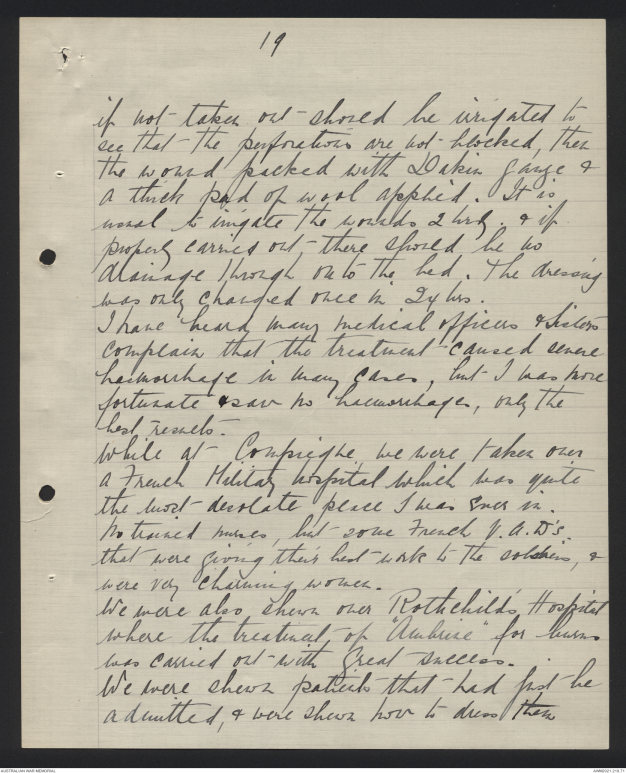
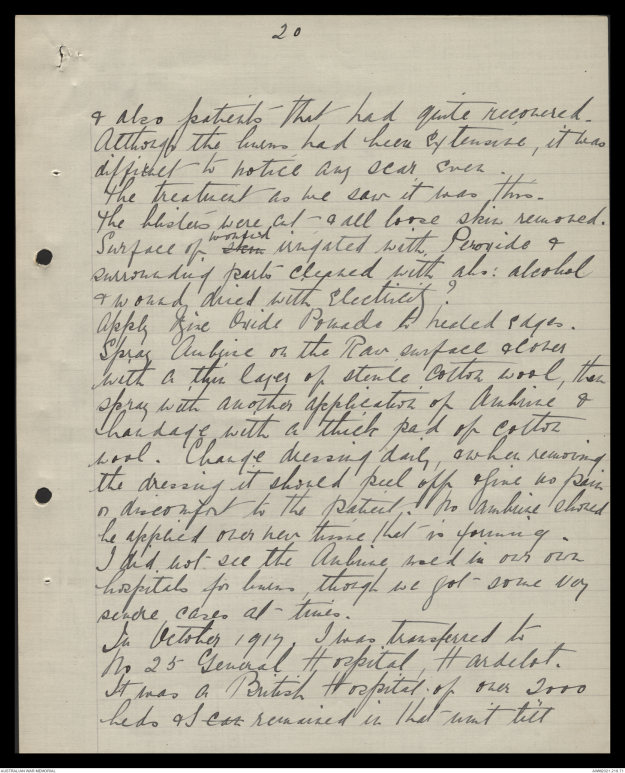
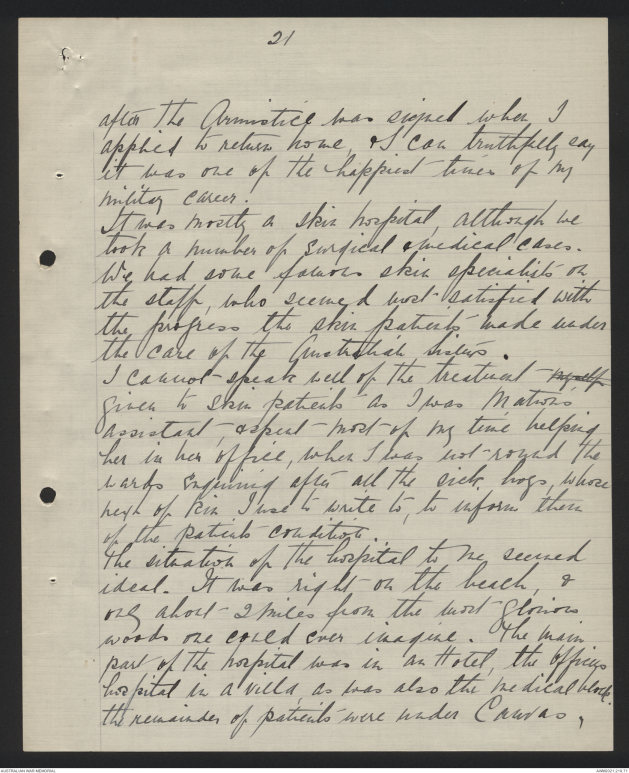
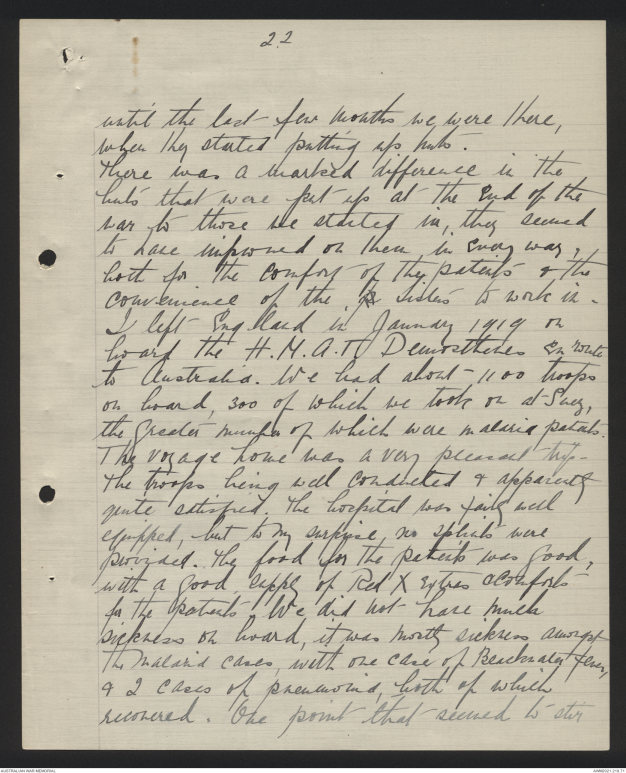
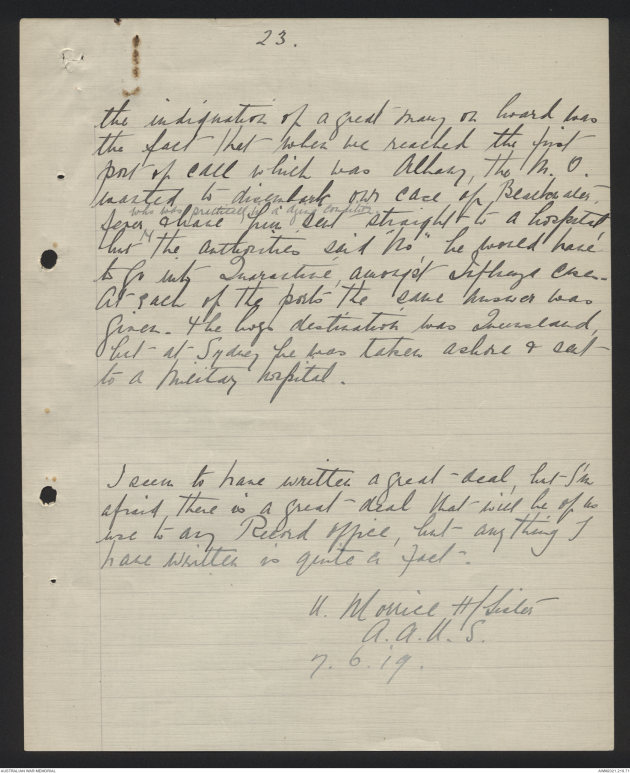
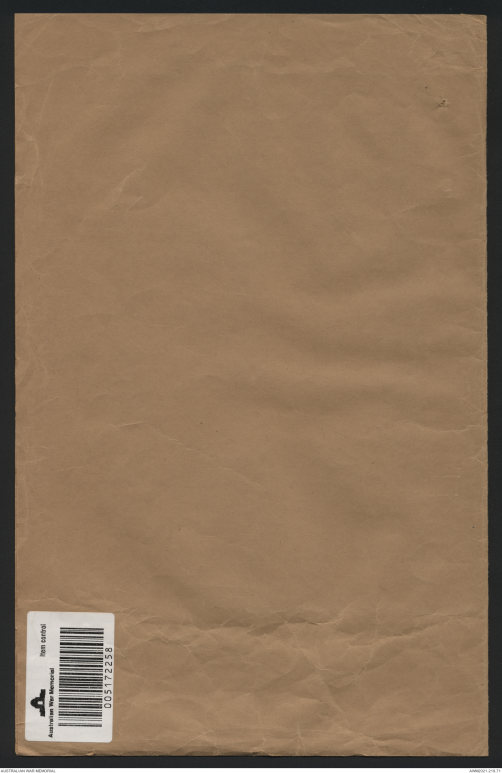
19
if not taken out should be irrigated to
see that the perforations are not blocked, then
the wound packed with Dakin gauze &
a thick pad of wool applied. It is
usual to irrigate the wounds 2 hrly. & if
properly carried out there should be no
drainage through on to the bed. The dressing
was only changed once in 24 hrs.
I have heard many medical officers & Sisters
complain that the treatment caused severe
haemorrhage in many cases, but I was more
fortunate & saw no haemorrhage, only the
best results.
While at Compiègne we were taken over
a French Military hospital which was quite
the most desolate place I was ever in.
No trained nurses, but some French V.G.D.’S
that were giving their best work to the soldiers, &
were very charming women.
We were also shown over Rothchild’s Hospital
where the treatment of “Ambrine” for burns
was carried out with great success.
We were shown patients that had just be
admitted, & were shown how to dress them
20.
& also patients that had quite recovered.
Although the burns had been extensive, it was
difficult to notice any scar even.
The treatment as we saw it was this.
The blisters were cut and all loose skin removed.
Surface of wound xxxx irrigated with Peroxide &
surrounding parts cleaned with als: alcohol
& wound dried with electricity?
Apply Zinc Oxide Pomade to healed edges.
Spray Ambrine on the Raw surface & cover
with a thin layer of sterile cotton wool, then
spray with another application of Ambrine &
bandage with a thick pad of cotton
wool. Change dressing daily, & when removing
the dressing it should peel off & give no pain
or discomfort to the patient. No Ambrine should
be applied over new tissue that is forming.
I did not see the Ambrine used in our own
hospitals for burns, though we got some very
severe cases at times.
In October 1917, I was transferred to
No 25 General Hospital, Hardelot.
It was a British Hospital of over 2000
beds & I can remained in that unit till
21.
after the Armistice was signed when I
applied to return home, & I can truthfully say
it was one of the happiest times of my
military career.
It was mostly a skin hospital, although we
took a number of surgical & medical cases.
We had some famous skin specialists on
the staff, who seemed most satisfied with
the progress the skin patients made under
the care of the Australian Sisters.
I cannot speak well of the treatment myself
given to skin patients as I was Matron’s
assistant, & spent most of my time helping
her in her office, when I was not round the
wards enquiring after all the sick boys, whose
next of kin. I use to write to, to inform them
of the patients condition.
The situation of the hospital to me seemed
ideal. It was right on the beach, &
only about 2 miles from the most glorious
woods one could ever imagine. The main
part of the hospital was in an Hotel, the Officers
hospital in a villa, as was also the medical block.
the remainder of patients were under Canvas,
22.
until the last few months we were there,
when they started putting up huts.
There was a marked difference in the
huts that were put up at the end of the
war to those we started in, they seemed
to have improved on them, in every way,
both for the comfort of the patients & the
convenience of the xx Sisters to work in.
I left England in January 1919 on
board the H.M.A.T. Demosthenes en route
to Australia. We had about 1100 troops
on board, 300 of which we took on at Suez,
the greater number of which were malaria patients.
The voyage home was a very pleasant trip -
the troops being well conducted & apparently
quite satisfied. The hospital was fairly well
equipped, but to my surprise no splints were
provided. The food for the patients was good,
with a good supply of Red X extras & comforts
for the patients. We did not have much
sickness on board, it was mostly sickness amongst
the malaria cases, with one case of Bartonella fever,
& 2 cases of pneumonia, both of which
recovered. One point that seemed to stir
23.
the indignation of a great many on board was
the fact that when we reached the first
port of call which was Albany, the M.O.
wanted to disembark our case of Bartonella
fever ^who was practically in a dying condition & have him sent straight to a hospital,
but the authorities said “no”, he would have
to go into Quarantine, amongst Influenza cases.
At each of the ports the same answer was
given. The boys destination was Queensland,
but at Sydney he was taken ashore & sent
to a Military hospital.
I seem to have written a great deal, but I’m
afraid there is a great deal that will be of no
use to any Record Office, but any thing I
have written is quite a fact.
N. Morrice H/Sister
A.A.U.S.
7.6.19.
AUSTRALIAN WAR MEMORIAL
005172258
 Sam scott
Sam scottThis transcription item is now locked to you for editing. To release the lock either Save your changes or Cancel.
This lock will be automatically released after 60 minutes of inactivity.